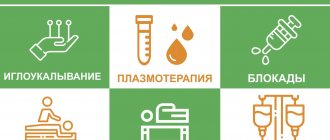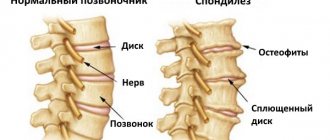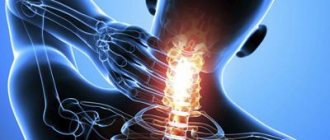Spondylosis is a common condition in the 21st century. This is medical terminology that refers to a series of processes or abnormalities that have occurred in the spine. Spondylosis manifests itself mainly in older people, but due to intense physical activity, a sedentary lifestyle or congenital pathology, abnormalities in the spine are present even in children.
There are three types of spondylosis: thoracic, cervical, lumbar. The names describe the area in which the problem occurred. The least common type is spondylosis of the thoracic spine. But if such a disease occurs, it is necessary to urgently begin diagnosis and begin treatment.
What is thoracic spondylosis?
Thoracic spondylosis is characterized by a condition in which the spinal canal narrows, resulting in the arrest of the spinal cord and nerve endings. This is very dangerous, because with further development the pathology leads to numbness, impaired coordination of movements and partial paralysis.
Thoracic spondylosis is very rare. Lesions of the cervical and lumbar spine are more common. But it is the disease of the thoracic spine that you should be wary of. In addition to damage to the nerve endings, osteophyte may develop - a bone spike that presses on the spinal roots of the nerves and provokes constant pain when moving.
How to do a spinal block:
Depending on the technique used, spinal blockade is done in 3 ways:
- paravertebral;
- epidural;
- articularly.
The doctor selects the injection site taking into account the location of the pathology.
Paravertebral
The solution is injected into the area closest to the damaged vertebra, in the area where the nerve passes at the level of the transverse vertebral processes. There is no interference with the spinal membranes.
For paravertebral blockade, the needle is inserted to a depth of 5-6 cm
Epidural
It is used for lumbar hernia and blocks the roots of the spinal nerves. It involves the introduction of a medicinal solution into the epidural space - the area between the periosteum of the vertebrae and the dura mater of the spinal cord.
Kazieva Aminat Ziyavovna
Neurologist
Rostov State Medical University
Experience since 2012
The blockade is carried out in a position on the side, less often - lying on the stomach.
Articular
Involves the introduction of medication into the cavity of the facet joints. Most effective for lumbar hernia.
The SmartMed clinic uses a relatively new method of pain relief - periarticular block. The anesthetic is injected into the muscles, tendons and ligaments that surround the joint, that is, into the periarticular tissue.
Causes of thoracic spondylosis
Age is considered the main cause of thoracic spondylosis. The disease is diagnosed in people over 50 years of age. During the aging process, the intervertebral discs in the thoracic region wear out, lose their former stability and part of their functionality. A hernia or osteophyte - a bone spike - may form at the site of damage. Such development of pathology leads to a large-scale load on the entire body and provokes severe pain.
The second reason is severe injury. Rarely seen. Even after a severe fracture, degradation of the vertebral discs in the thoracic region does not always occur.
Symptomatic manifestations
The thoracic part of the spinal column is the least loaded. Often, the cause of thoracic spondylosis is damage to the spine in the cervical or lumbar region. Sometimes you need to start by looking for symptoms of other types of spondylosis to identify the thoracic type.
Here are some symptoms that occur with this disease:
- impaired coordination of movements;
- frequent pain even in a stationary position;
- feeling of stiffness in the middle of the back;
- muteness of the upper and lower extremities;
- back pain immediately after waking up;
- discomfort in the thoracic spine during movement;
- chest pain is a rare but possible symptom;
- difficulty walking.
The symptoms cannot be called specific, so a thorough diagnosis is needed to determine the cause of the discomfort.
Which doctor performs the therapeutic blockade?
A blockade can only be performed by a qualified neurologist who knows its technique, indications and contraindications, possible complications, and also has perfect knowledge of anatomy and the structure of the spine.
An untrained professional can cause irreparable harm. If the blockade technique for pain in the spine due to a hernia or the rules of asepsis are not followed, the manipulation is dangerous. The following consequences are likely:
- damage to nerve endings with subsequent disruption of the innervation of certain areas of the body;
- paresis, paralysis;
- infection of the spinal cord with the development of myelitis and other infectious complications.
When contacting professionals, a spinal block is an absolutely safe procedure, an effective method of treating acute and chronic pain in neurology. Fear of pain from an injection or damage to the spinal cord is unfounded if the manipulation is performed by an experienced doctor.
Novocaine or other anesthetic blockade of the spine does not hurt. There are unpleasant sensations at the beginning of the manipulation, but they are tolerable and are caused by the needle itself. No additional anesthesia is required.
After the blockade, a three-stage pain reduction occurs
As for the risk of damage to the spinal endings, it is practically zero. The needle is not inserted into the spinal cord or spine, but into the soft tissue that is near the pinched nerve, spasmed muscle, or other source of pain. There is no need to be afraid.
Note! After a spinal block is performed, skin sensitivity may decrease at the injection site, but this is a temporary side effect. Other negative reactions are also likely: headache, dizziness, decreased blood pressure, nausea.
Kazieva Aminat Ziyavovna
Neurologist
Rostov State Medical University
Experience since 2012
Make an appointment with a neurologist at the medical office. The doctor will tell you in detail how and why the blockade is done, whether it is suitable for you, whether the procedure is painful, and what consequences may occur after it.
Diagnosis of thoracic spondylosis
You need to contact a neurologist, neurosurgeon or orthopedist. You can start by visiting a therapist, who will write a referral to the right specialist.
Diagnostics is divided into two stages: collecting anamnesis and information about the patient and conducting a hardware examination. The first part is carried out immediately at the reception. The doctor interviews the patient, takes notes, and performs a visual examination to determine what type of disease he is dealing with. If there is not enough data, a hardware examination is performed.
To confirm the diagnosis, you need a method that allows you to visually examine the affected area. For these purposes, fluoroscopy, MRI or computed tomography are used. If there is deformation, it will be displayed on the device screen.
As soon as the data collection is completed, the doctor will draw up a clinical picture and begin treatment of spondylosis of the thoracic spine.
Methods for treating thoracic spondylosis
Spondylosis of the thoracic spine can be treated in different ways. If the problem is not serious, you can only manage with conservative methods that do not involve direct medical intervention - surgery. Otherwise, the actions of specialists will be based on how great the risk is for the patient.
Conservative methods
A conservative technique is used if the symptoms of the disease are “sluggish”, not intense, and periodic. Typically, chronic pain syndrome occurs rarely, so specialists limit themselves to mixed therapy: conservative and medicinal.
To treat thoracic spondylosis in a patient, the following methods are used:
- Acupuncture. Helps eliminate pain and swelling in the cervical spine. Small needles, as thick as a human hair, are distributed over the patient's body. Depending on the type of procedure, the needles are heated, an electric current is passed through them (under low voltage) or scrolled. The result of the procedure is a reduction in pain and increased mobility.
- Maintaining bed rest. A measure that is resorted to only in serious cases. The patient's spine should be given a long rest before full treatment begins. Bed rest does not last long - from 2 to 3 days. Otherwise, the risk of thrombosis increases.
- Fixing corsets. A short-term therapeutic measure that allows you to reduce the load on the affected area of the spine, restore the mobility of the intervertebral disc and relax the back muscles. Unfortunately, you can use the corset for no more than 7 days.
- Manual therapy. Without a fully functioning nervous system there will be no healthy body. If a nerve has been damaged, it must be restored as soon as possible to avoid long-term pain. Using manual manipulation, the chiropractor “straightens” the vertebrae, relaxes and increases the mobility of the motion segment.
- Improving everyday life. This is a whole group of methods aimed at improving the patient's condition. The diet will need to be stabilized (excluding fried, fatty, salty and sweet foods), and daily exercise will be mandatory. Accordingly, this means a complete abstinence from alcoholic beverages.
All of the above methods can be used individually or combined with each other. The attending physician will decide, at his own discretion, what to do in a particular case.
Drug therapy
An integral part of the conservative treatment of spondylosis of the thoracic spine is drug therapy. If both methods are used simultaneously, spondylosis of the thoracic spine will be cured quickly.
The patient is prescribed the following medications:
- Muscle relaxants. Reduce the load on the muscles of the spinal region, eliminate spasms and pain.
- Opioids. A last resort, prescribed only for severe systematic pain.
- NSAIDs. A group of anti-inflammatory medications designed to reduce inflammation in the affected area.
Other medications, in particular painkillers, are prescribed by a specialist. It is prohibited to take medications on your own without the knowledge of a doctor.
Other treatments
In addition to conservative and drug therapy, there are many other types of treatment for thoracic spondylosis:
- Physiotherapy. A therapeutic, preventive and corrective measure rolled into one. Therapy uses ultrasound, electrical stimulation or balancing with cold and heat. The procedures are aimed at reducing pain.
- Spinal injections. This method is used quite rarely, but it is worth mentioning. Steroids and anesthetics are simultaneously injected into the facet joints, which suppress the inflammatory response in the nerve tissues, which leads to a reduction in pain and the return of the former mobility of the back muscles.
- Hydrotherapy. Simultaneously a therapeutic and preventive procedure. Helps with poor coordination of movements, severe pain in the thoracic spine and aching joints. The difference from swimming is that the patient performs certain manipulations while in the water. Helps restore a degenerative vertebra or joint.
- Taping. The method, based on further reducing the likelihood of new injuries, is used as a rehabilitation measure. Using a special adhesive tape that is attached to the back, doctors maintain the stability of specific muscle groups, protect the tendons from rupture and sprains, and fix the soft tissue.
- Impact on soft tissue. It can be performed both before and after treatment of spondylosis. If the soft tissue has been damaged, and this is what caused the development of the disease, it is imperative to bring it back to normal in order to avoid recurrence of the problem in the future.
Each method is aimed at reducing pain in the back, joints and muscles. Once the pain begins to subside, mobility will gradually return.
Why do osteophytes appear?
If the muscles and ligaments are weakened, then the neighboring vertebrae become unstable and begin to “play” - shift relative to each other. The receptors are constantly irritated, causing pain. To avoid this discomfort, the body tries to cope with the problem on its own by fixing the spine, increasing the contact area of the vertebrae by building up bone tissue and compressing muscles. Thus, the course of the disease provides the key to the solution - improving the condition of the muscles is very important in order to avoid the formation of osteophytes.
Preventive measures
Treatment of spondylosis of the thoracic spine is not considered complete until the patient has undergone prevention or correction. Spondylosis is a complex disease that can return at any time if it is not completely treated in a timely manner. Any element of the thoracic spinal column can become deformed at the most inopportune time.
First of all, the entire therapeutic course must be completed, down to the last pill or procedure. During the time that the doctor has determined for treatment, the injury that caused spondylosis must be eliminated. But no one bothers you to take certain preventive measures during and after therapy.
Here are some recommendations:
- Adjust your diet. With age, consumption of junk food can become a “starter” for the development of spondylosis. This is especially true for salty foods, because salt accumulates in joints and cartilage, dehydrating them and making them more fragile.
- Get yourself in good physical shape. If you are overweight, it is advisable to get rid of it, because obesity creates additional stress not only on the spinal column, but also on the entire body.
- Continue physical exercise. If you keep the back muscles in the appropriate condition, they will act as a “support” for the spine and will not allow it to collapse prematurely.
For several months after completion of treatment, you need to continue monitoring with a specialist. If changes are noticed, it is advisable to correct them immediately so that a minor problem does not turn into full-fledged spondylosis. Accordingly, you need to avoid physical activity, strength exercises and follow your doctor’s recommendations.
Benefits of MBST Therapy
Among the methods that can be considered revolutionary, MBST therapy (nuclear magnetic resonance therapy) stands out. Its peculiarity and at the same time its advantages lie in its effect on the patient’s cells, which begin to regenerate and renew themselves.
The technique has been refined and is used for the treatment of spondylosis of the thoracic spine, even in chronic degenerative diseases of the joints or intervertebral discs. Today, nuclear magnetic resonance therapy is the only way to influence the patient’s cells.
The result of the procedure is the easing of pain, a decrease in symptomatic manifestations, and the healing of crushed or deformed bones. Meniscal rupture, injuries received as a result of vigorous physical or sports activity, intervertebral disc protrusion - all this can be cured using MBST therapy.
Why is MBST therapy so popular and in demand among patients? The methodology involves treating the spine without the intervention of surgeons. There is no risk for the patient, and the therapy has no side effects or complications.
Preparations for performing spinal blockade for hernia
A spinal block is prescribed by a neurologist or vertebrologist, who also determines the dose and type of drug. For hernia, both mono- and multi-component compositions are used.
All drugs that are used for blockade can be divided into 2 groups:
- Anti-inflammatory. These include hormonal medications that reduce inflammation and swelling and have a therapeutic effect.
- Painkillers. The main purpose of drugs in this group is to block the transmission of pain impulses. To eliminate pain when a nerve is pinched, injections of Lidocaine or Novocaine are given.
Mixed formulations are often used - a mixture of anti-inflammatory and painkillers. Injections with hormonal drugs alone are less effective, and they are also painful.
Note! Therapeutic blockades for radiculitis, hernia, osteochondrosis are safe in medicine, practically not accompanied by side effects, since the active substance is administered locally, to the lesion. It enters the general bloodstream only in small doses.
Novocaine
It is a local anesthetic, relieves muscle spasms, and has a pronounced analgesic effect. The blockade effect occurs within 10-15 minutes.
Although spinal blockade with novocaine is considered one of the safest in medicine, patients often experience allergic reactions, so other anesthetics are used.
Lidocaine
Lidocaine blockades are performed at the SmartMed clinic. Lidocaine is less toxic and provides a faster and longer lasting analgesic effect than Novocaine. In addition, lidocaine solutions have a vasodilating effect and do not cause an increase in blood pressure.
Diprospan
This is a hormonal drug based on betamethasone. It not only relieves inflammation, but also relieves pain, does not cause allergic reactions, and provides a long-lasting effect.
Diprospan can treat any destructive-degenerative diseases of the spine, spasm of the gluteal muscle. It is suitable for vertebral and epidural administration.
Hydrocortisone
Less effective than Diprospan. Hydrocortisone blockades are indicated for patients with mild pain syndrome, since its analgesic effect is short-lived.
Hydrocortisone is most often used in multicomponent formulations because it prolongs the action of anesthetics
The main advantage of the drug is its low cost.
Depo-Medrol
Refers to hormonal drugs. The medicine is used to block soft tissues and joints, including not only facet joints, but also knee joints. It is not suitable for vertebral or epidural manipulations, but is ideal for periarticular blocks.
Note! To restore bones and cartilage tissue of the knee, hormonal drugs can be combined with chondroprotectors. mineral complexes.
Dexamethasone
Has a prolonged anti-inflammatory effect. It is 25-30 times more active than Hydrocortisone, so in severe cases it is preferred and combined with lidocaine solutions.










